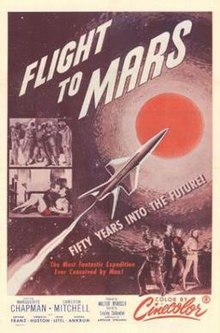
The Martian Chronicles is a science fiction fix-up novel, published in 1950, by American writer Ray Bradbury that chronicles the exploration and settlement of Mars, the home of indigenous Martians, by Americans leaving a troubled Earth that is eventually devastated by nuclear war.

Devil Girl from Mars is a 1954 British second feature black-and-white science fiction film, produced by the Danziger Brothers, directed by David MacDonald and starring Patricia Laffan, Hugh McDermott, Hazel Court, Peter Reynolds, and Adrienne Corri. It was released by British Lion, and released in the United States the following year. A female alien is sent from Mars to acquire human males to replace their declining male population. When negotiation, then intimidation, fails she must use force to obtain co-operation from a remote Scottish village where she has landed her crippled flying saucer.
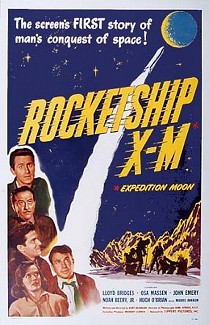
Rocketship X-M is a 1950 American black-and-white science fiction film from Lippert Pictures, the first outer space adventure of the post-World War II era. The film was produced and directed by Kurt Neumann and stars Lloyd Bridges, Osa Massen, John Emery, Noah Beery Jr., Hugh O'Brian, and Morris Ankrum.

Destination Moon is a 1950 American Technicolor science fiction film, independently produced by George Pal and directed by Irving Pichel, that stars John Archer, Warner Anderson, Tom Powers, and Dick Wesson. The film was distributed in the United States and the United Kingdom by Eagle-Lion Classics.

It! The Terror from Beyond Space is an independently made 1958 American science fiction horror film, produced by Robert Kent, directed by Edward L. Cahn, that stars Marshall Thompson, Shawn Smith, and Kim Spalding. The film was distributed by United Artists as a double feature with Curse of the Faceless Man.
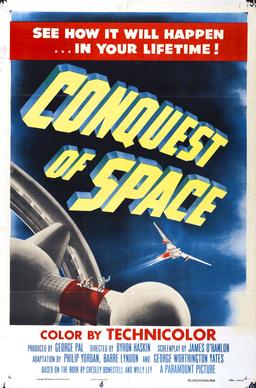
Conquest of Space is a 1955 American Technicolor science fiction film from Paramount Pictures, produced by George Pal, directed by Byron Haskin, that stars Walter Brooke, Eric Fleming, and Mickey Shaughnessy.

Mission to Mars is a 2000 American science fiction adventure film directed by Brian De Palma, written by Jim Thomas, John Thomas, and Graham Yost, and suggested by Disney's theme park attraction of the same name. The film depicts the first crewed Mars exploration mission going awry; American astronaut Jim McConnell helps to coordinate a rescue mission for a colleague. Principal support actors were Tim Robbins, Don Cheadle, Connie Nielsen, Jerry O'Connell, and Kim Delaney.

Sleepers of Mars is a collection of five early stories by British writer John Wyndham, as by John Beynon Harris, published after his death, in 1973 by Coronet Books.

Klaatu is a fictional humanoid alien character best known from his appearances in the 1951 science fiction film The Day the Earth Stood Still and its 2008 remake. The character of Klaatu gained popularity partly due to the iconic phrase "Klaatu barada nikto!" associated with the character.

Mission Stardust is a 1967 science fiction film based on the early novels of the popular German Perry Rhodan series by K.H. Scheer and Walter Ernsting.

Robinson Crusoe on Mars is a 1964 American science fiction film directed by Byron Haskin and produced by Aubrey Schenck that stars Paul Mantee, Victor Lundin, and Adam West. It is a science fiction retelling of the classic 1719 novel Robinson Crusoe by Daniel Defoe. The film was distributed by Paramount Pictures and filmed in Technicolor and Techniscope.
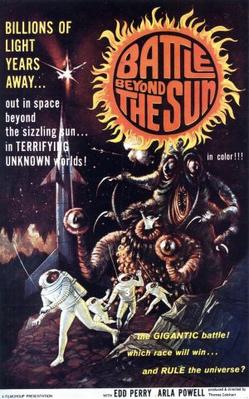
Battle Beyond the Sun is a 1962 science fiction film. It is an English-dubbed and re-edited American version of Nebo Zovyot, a 1959 Soviet science fiction film. Roger Corman acquired the Soviet film for US distribution and hired a young film-school student named Francis Ford Coppola to "Americanize" it.

Space-Men is a 1960 Italian science fiction film directed by Antonio Margheriti. The film stars Rik Van Nutter and co-stars Gabriella Farinon, David Montresor, Archie Savage, and Alain Dijon. The film was released in the United States in 1961 by American International Pictures.

The Martian Chronicles is a 1980 television three-episode miniseries based on Ray Bradbury's 1950 book The Martian Chronicles and dealing with the exploration of Mars and the inhabitants there. The series starred Rock Hudson, Darren McGavin, Bernadette Peters, Roddy McDowall, Fritz Weaver, Barry Morse, and Maria Schell. It was aired on NBC in January 1980 in three episodes with a total running time of just over four hours. The series depicts Mars as having a "thin atmosphere" which humans can breathe, with water-filled canals and desert-like vegetation. The miniseries was directed by Michael Anderson and written by Richard Matheson.

The Purple Monster Strikes is a 1945 Republic Movie serial. It was also released as a Century 66 television film under the title D-Day on Mars (1966).
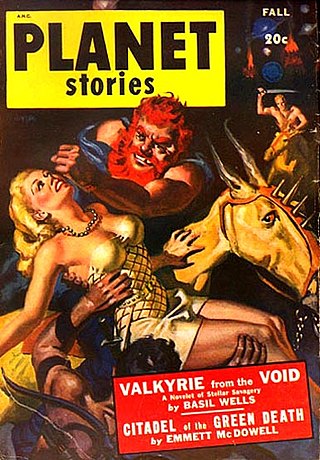
"Mars Is Heaven!" is a science fiction short story by American writer Ray Bradbury, originally published in 1948 in Planet Stories. "Mars Is Heaven!" was among the stories selected in 1970 by the Science Fiction Writers of America as one of the best science fiction short stories published before the creation of the Nebula Awards. As such, it was published in The Science Fiction Hall of Fame Volume One, 1929–1964. It also appears as the sixth chapter of The Martian Chronicles, revised as "The Third Expedition."
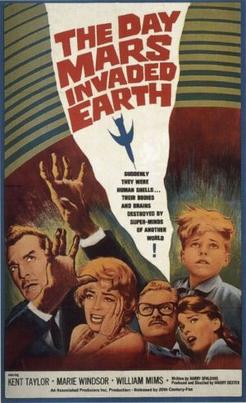
The Day Mars Invaded Earth is an independently made 1963 black-and-white CinemaScope science fiction film, produced and directed by Maury Dexter, that stars Kent Taylor, Marie Windsor, and William Mims. The film was released by Twentieth Century Fox. Dexter later said the film's title came from Associated Producers' Robert L. Lippert and was meant to evoke memories of Fox's 1951 classic The Day the Earth Stood Still.

Marooned on Mars is a juvenile science fiction novel written by American writer Lester del Rey. It was published by John C. Winston Co. in 1952 with illustrations by Alex Schomburg.
Space Probe Taurus is a 1965 low budget black-and-white science fiction/action/drama film from American International Pictures, written and directed by Leonard Katzman, and starring Francine York, James E. Brown, Baynes Barrow, and Russ Bender.

The Secret of the Ninth Planet is a science-fiction novel written by Donald A. Wollheim and first published in the United States in 1959 by the John C. Winston Co. Wollheim takes his heroes on a grand tour of the Solar System as that team struggles to prevent an alien force from blowing up the Sun. This is the last of three juvenile novels that Wollheim wrote for Winston, the other two being The Secret of Saturn's Rings and The Secret of the Martian Moons.
